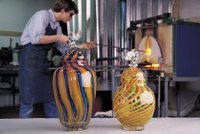
The Glass is an amorphous substance made primarily of silica (derived from sand, flint, or quartz), fused at high temperatures with borates or phosphates.
It is neither a solid nor a liquid but exists in a vitreous, or glassy, state in which molecular units have disordered arrangement but sufficient cohesion to produce mechanical rigidity. Glass is cooled to a rigid state without the occurrence of crystallization; heat can reconvert glass to a liquid form. Usually transparent, glass can also be translucent or opaque. Color varies with the ingredients of the batch.
 Glass was first made before 2000 bc and has since served humans in many ways. It has been used to make useful vessels as well as decorative and ornamental objects, including jewelry. Glass also has architectural and industrial applications.
Glass was first made before 2000 bc and has since served humans in many ways. It has been used to make useful vessels as well as decorative and ornamental objects, including jewelry. Glass also has architectural and industrial applications.The Float Process offers to the market of the construction leaves of glass of great size and perfection, not only by its flat completion, but by its low optical distortion and faults. With the use of the glass in remodelings and improvements, the benefits of new products, like the smaller costs of energy, extend to existing buildings. The glass comprises integral of most of the construction projects.
As much the new buildings as the remodeling of existing require great amounts of glass.

The architects look for bring the outside to the interior of the building, and to maximize the natural light. Thus, the areas with glass are more and more ample in facades and ceilings but the remodeling of buildings represents around 40% of the consumption of glass world-wide level.



1 comment:
Pedro, you should write the link to the page or pages where you got the information from.
Dafne
Post a Comment